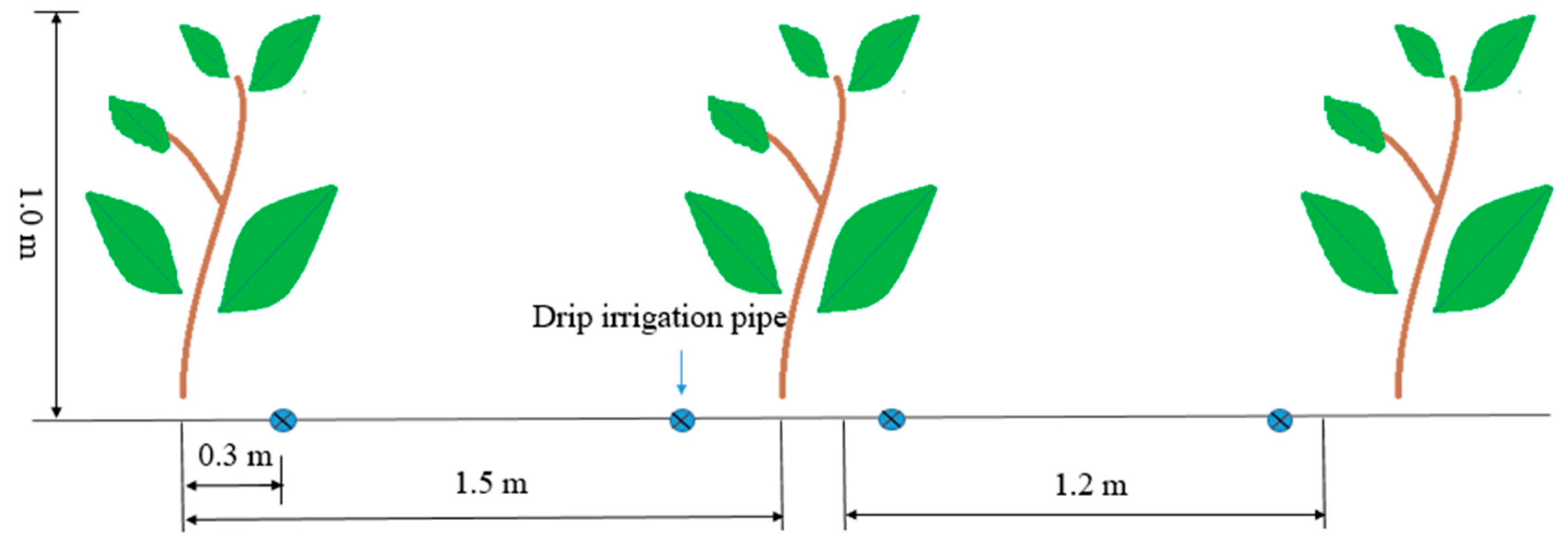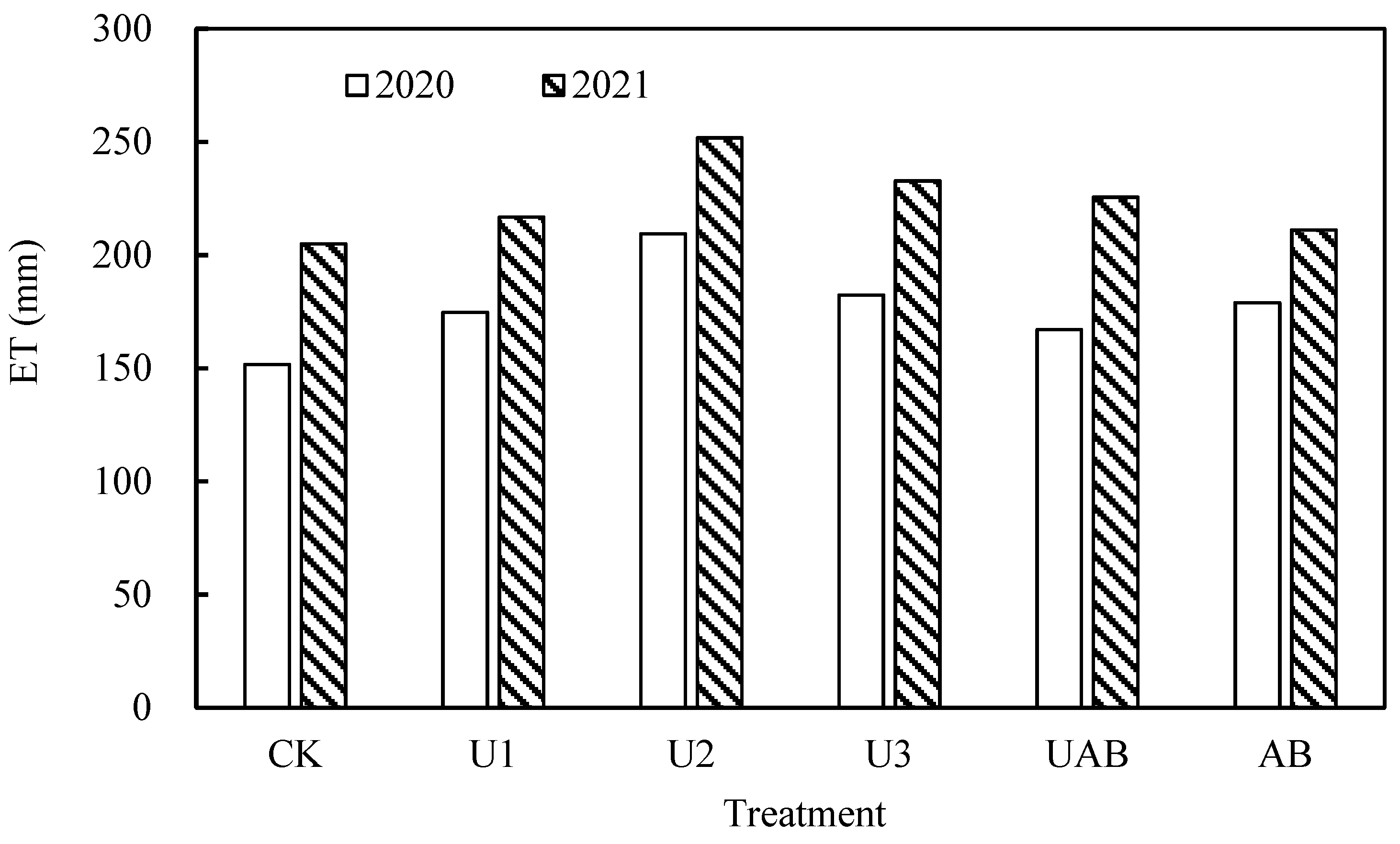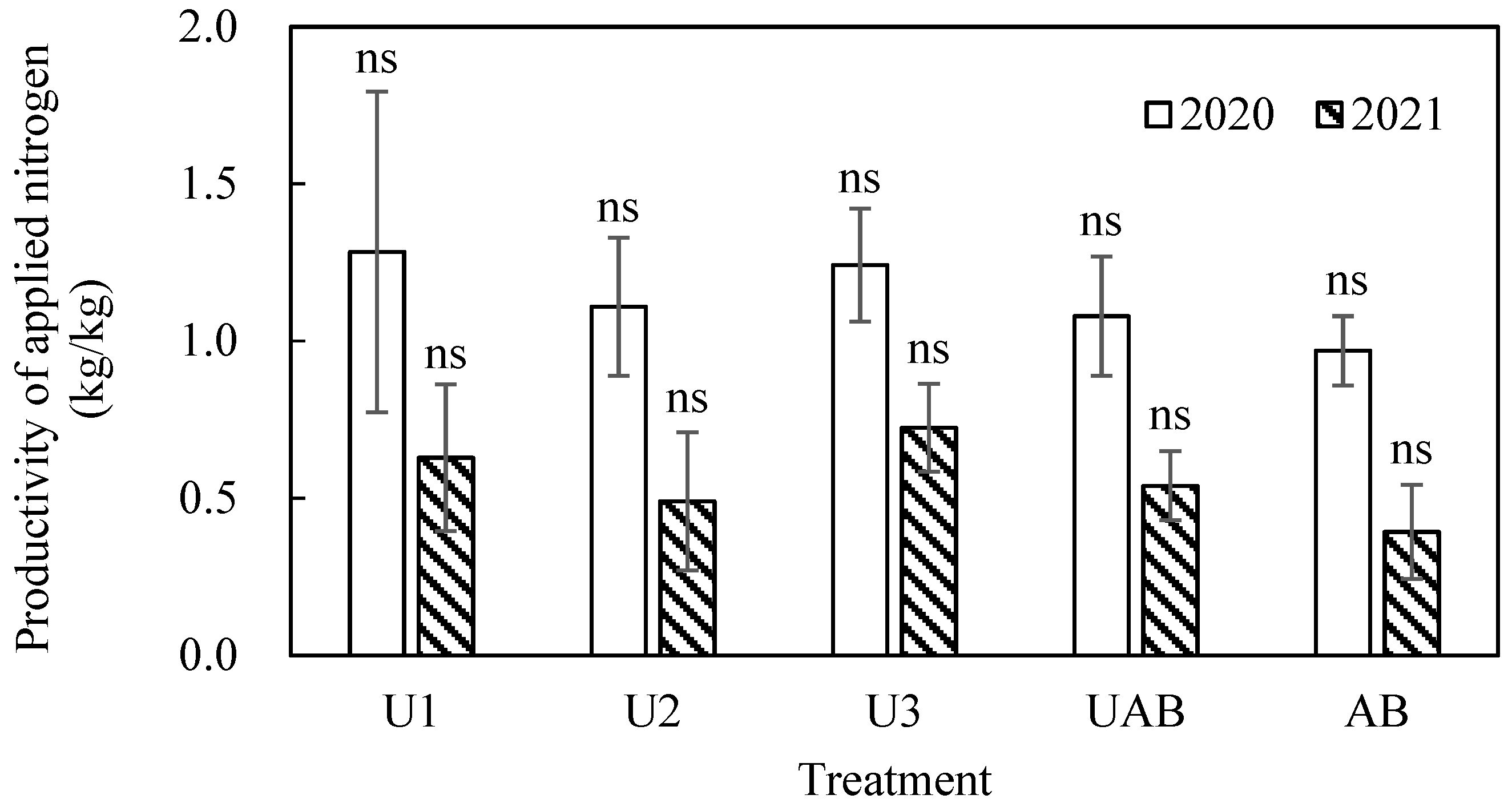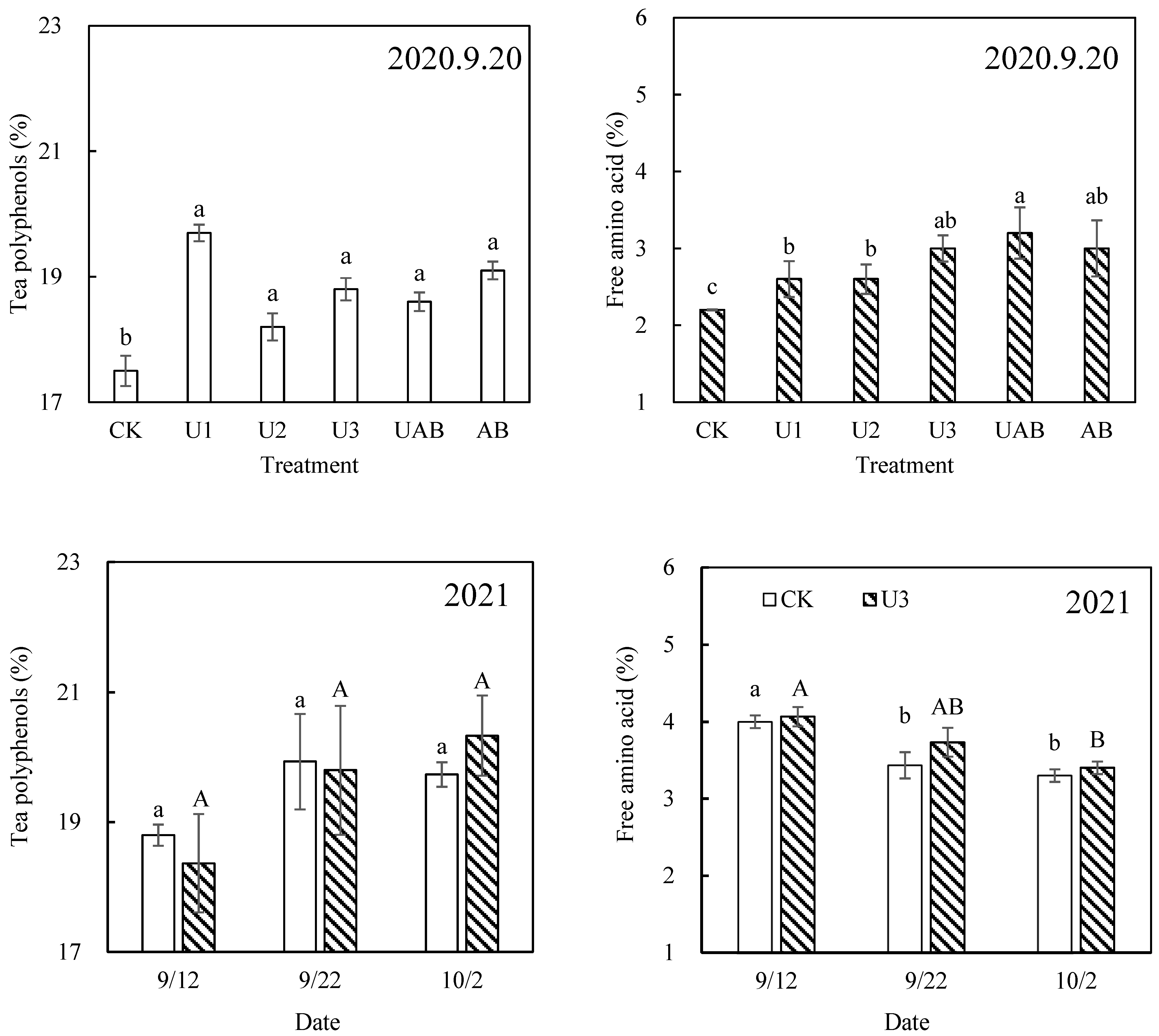Appropriate Nitrogen Form and Application Rate Can Improve Yield and Quality of Autumn Tea with Drip Irrigation
Abstract
1. Introduction
2. Materials and Methods
2.1. Experimental Site
2.2. Experimental Design
2.3. Irrigation Regime
2.4. Fertilizer Regime
2.5. Observation Indexes and Sampling
2.5.1. Soil Moisture Content, Soil Nitrate Nitrogen and Ammonium Nitrogen Content
2.5.2. Evapotranspiration of Tea Trees
2.5.3. Tea Yield and Quality Composition
2.6. Nitrogen Application Productivity
2.7. Statistical Analysis
3. Results
3.1. Soil Moisture Content
3.2. Evapotranspiration of Tea Plants
3.3. Changes of Nitrate Nitrogen and Ammonium Nitrogen Content at 0–60 cm Soil Layer
3.4. Yield
3.5. Productivity of Applied Nitrogen
3.6. Quality Component
4. Discussion
5. Conclusions
Author Contributions
Funding
Data Availability Statement
Acknowledgments
Conflicts of Interest
References
- Pang, Y.; Wang, F.A.; Huang, Z.A.; Li, B.B.; Hu, F.C.; Xia, Y.C. Improving yield and quality of autumn tea with drip irrigation under appropriate nitrogen and potassium fertilization. Trans. Chin. Soc. Agric. Eng. 2019, 35, 98–103. [Google Scholar]
- Dai, W.; Qi, D.; Yang, T.; Lv, H.; Guo, L.; Zhang, Y.; Zhu, Y.; Peng, Q.; Xie, D.; Tan, J.; et al. Nontargeted analysis using ultra performance liquid chromatography-quadrupole time-of-flight mass spectrometry uncovers the effects of harvest season on the metabolites and taste quality of tea (Camellia sinensis L.). J. Agric. Food Chem. 2015, 63, 9869–9878. [Google Scholar] [CrossRef] [PubMed]
- Xiao, Y.; Li, M.; Liu, Y.; Xu, S.; Zhong, K.; Wu, Y.; Gao, H. The effect of Eurotium cristatum (MF800948) fermentation on the quality of autumn green tea. Food Chem. 2021, 358, 129848. [Google Scholar] [CrossRef] [PubMed]
- Kaneko, S.; Kumazawa, K.; Masuda, H.; Henze, A.; Hofmann, T. Molecular and sensory studies on the umami taste of Japanese green tea. J. Agric. Food Chem. 2006, 54, 2688–2694. [Google Scholar] [CrossRef]
- Ruan, L.; Wei, K.; Wang, L.; Cheng, H.; Wu, L.; Li, H. Characteristics of free amino acids (the quality chemical components of tea) under spatial heterogeneity of different nitrogen forms in tea (Camellia sinensis) plants. Molecules 2019, 24, 415. [Google Scholar] [CrossRef]
- Manzoor; Ma, L.; Ni, K.; Ruan, J. Effect of integrated use of rapeseed cake, biochar and chemical fertilizers on root growth, nutrients use efficiency and productivity of tea. Agronomy 2022, 12, 1823. [Google Scholar] [CrossRef]
- Wang, Y.; Fu, D.; Pan, L.; Sun, L.; Ding, Z. The coupling effect of water and fertilizer on the growth of tea plants [Camellia sinensis (L.) O. Kuntz]. J. Plant Nutr. 2016, 39, 620–627. [Google Scholar] [CrossRef]
- Fan, K.; Zhang, J.; Wang, M.; Qian, W.; Sun, L.; Shen, J.; Ding, Z.; Wang, Y. Development and application of SNP-KASP markers based on genes related to nitrogen uptake, assimilation and allocation in tea plant (Camellia sinensis L.). Agronomy 2022, 12, 2534. [Google Scholar] [CrossRef]
- Tang, S.; Liu, Y.; Zheng, N.; Li, Y.; Ma, Q.; Xiao, H.; Zhou, X.; Xu, X.; Jiang, T.; He, P.; et al. Temporal variation in nutrient requirements of tea (Camellia sinensis) in China based on QUEFTS analysis. Sci. Rep. 2020, 10, 1745. [Google Scholar] [CrossRef]
- Ruan, L.; Wei, K.; Wang, L.; Cheng, H.; Zhang, F.; Wu, L.; Bai, P.; Zhang, C. Characteristics of NH4+ and NO3− fluxes in tea (Camellia sinensis) roots measured by scanning ion-selective electrode technique. Sci. Rep. 2016, 6, 38370. [Google Scholar] [CrossRef]
- Yang, X.; Ni, K.; Shi, Y.; Yi, X.; Zhang, Q.; Fang, L.; Ma, L.; Ruan, J. Effects of long-term nitrogen application on soil acidification and solution chemistry of a tea plantation in China. Agric. Ecosyst. Environ. 2018, 252, 74–82. [Google Scholar] [CrossRef]
- Ruan, J.; Gerendás, J.; Härdter, R.; Sattelmacher, B. Effect of nitrogen form and root-zone pH on growth and nitrogen uptake of tea (Camellia sinensis) plants. Ann. Bot. 2007, 99, 301–310. [Google Scholar] [CrossRef] [PubMed]
- Boschiero, B.; Mariano, E.; Trivelin, P. “Preferential” ammonium uptake by sugarcane does not increase the 15N recovery of fertilizer sources. Plant Soil 2018, 429, 253–269. [Google Scholar] [CrossRef]
- Yamashita, H.; Fukuda, Y.; Yonezawa, S.; Morita, A.; Ikka, T. Tissue ionome response to rhizosphere pH and aluminum in tea plants (Camellia sinensis L.), a species adapted to acidic soils. Plant-Environ. Interact. 2020, 1, 152–164. [Google Scholar] [CrossRef]
- Wang, J.; Tu, X.; Zhang, H.; Cui, J.; Ni, K.; Chen, J.; Cheng, Y.; Zhang, J.; Chang, S. Effects of ammonium-based nitrogen addition on soil nitrification and nitrogen gas emissions depend on fertilizer-induced changes in pH in a tea plantation soil. Sci. Total Environ. 2020, 747, 141340. [Google Scholar] [CrossRef] [PubMed]
- Claudia, M.; Julia, S.; Rudolf, S. Short-term nitrogen uptake of barley from differently processed biogas digestate in pot experiments. Energies 2019, 12, 696. [Google Scholar]
- Sitienei, K.; Kamiri, H.W.; Nduru, G.M.; Kamau, D.M. Nutrient budget and economic assessment of blended fertilizer use in Kenya tea industry. Appl. Environ. Soil Sci. 2018, 2563293. [Google Scholar] [CrossRef]
- Qiao, C.; Xu, B.; Han, Y.; Wang, J.; Wang, X.; Liu, L.; Liu, W.; Wan, S.; Tan, H.; Liu, Y.; et al. Synthetic nitrogen fertilizers alter the soil chemistry, production and quality of tea. A meta-analysis. Agron. Sustain. Dev. 2018, 38, 10. [Google Scholar] [CrossRef]
- Krzyżaniak, M.; Stolarski, M.; Warmiński, K. Life cycle assessment of giant miscanthus: Production on marginal soil with various fertilisation treatments. Energies 2020, 13, 1931. [Google Scholar] [CrossRef]
- Ipinmoroti, R.; Adeoye, G.; Makinde, E. Effects of urea-enriched organic manures on soil fertility, tea seedling growth and pruned yield nutrient uptake in Ibadan, Nigeria. Bulg. J. Agric. Sci. 2008, 14, 592–597. [Google Scholar]
- Islam, M.; Yaseen, T.; Traversa, A.; Ben Kheder, M.; Brunetti, G.; Cocozza, C. Effects of the main extraction parameters on chemical and microbial characteristics of compost tea. Waste Manag. 2016, 52, 62–68. [Google Scholar] [CrossRef] [PubMed]
- Yu, J.; Lin, S.; Shaaban, M.; Ju, W.; Fang, L. Nitrous oxide emissions from tea garden soil following the addition of urea and rapeseed cake. J. Soil. Sediment. 2020, 20, 3330–3339. [Google Scholar] [CrossRef]
- Sui, C.; Guan, X.; Zhang, W.; Zeng, B.; Zhang, Q.; Luo, L.; Hu, L.; Liu, L. Tea plant growth and soil nutrients in response to the application of fertilizer in Guizhou province, China. Agron. J. 2022, 114, 2011–2020. [Google Scholar] [CrossRef]
- Li, C.; Li, Y.; Cui, D.; Li, Y.; Zou, G.; Thompson, R.; Wang, J.; Yang, J. Integrated crop-nitrogen management improves tomato yield and root architecture and minimizes soil residual N. Agronomy 2022, 12, 1617. [Google Scholar] [CrossRef]
- Yang, K.; Wang, F.; Shock, C.; Kang, S.; Huo, Z.; Song, N.; Ma, D. Potato performance as influenced by the proportion of wetted soil volume and nitrogen under drip irrigation with plastic mulch. Agric. Water Manag. 2017, 179, 260–270. [Google Scholar] [CrossRef]
- Sidhu, H.; Jat, M.; Singh, Y.; Sidhu, R.; Gupta, N.; Singh, P.; Singh, P.; Jat, H.S.; Gerard, B. Sub-surface drip fertigation with conservation agriculture in a rice-wheat system: A breakthrough for addressing water and nitrogen use efficiency. Agric. Water Manag. 2019, 216, 273–283. [Google Scholar] [CrossRef]
- Chapagain, A.K.; Hoekstra, A.Y. The water footprint of coffee and tea consumption in the Netherlands. Ecol. Econ. 2007, 64, 109–118. [Google Scholar] [CrossRef]
- Yi, J.; Li, Y.; Gu, S. Temporal-spatial variations of water requirement for tea plants in Guizhou Province during 1961–2010. Chin. Agric. Sci. Bull. 2015, 31, 167–173. [Google Scholar]
- Zheng, S.; Ni, K.; Ji, L.; Zhao, C.; Chai, H.; Yi, X.; He, W.; Ruan, J. Estimation of evapotranspiration and crop coefficient of rain-fed tea plants under a subtropical climate. Agronomy 2021, 11, 2332. [Google Scholar] [CrossRef]
- Nie, T.; Chen, P.; Zhang, Z.; Qi, Z.; Lin, Y.; Xu, D. Effects of different types of water and nitrogen fertilizer management on greenhouse gas emissions, yield, and water consumption of paddy fields in cold region of China. Int. J. Environ. Res. Public Health 2019, 16, 1639. [Google Scholar] [CrossRef]
- Ye, T.; Ma, J.; Zhang, P.; Shan, S.; Liu, L.; Tang, L.; Cao, W.; Liu, B.; Zhu, Y. Interaction effects of irrigation and nitrogen on the coordination between crop water productivity and nitrogen use efficiency in wheat production on the North China Plain. Agric. Water Manag. 2022, 271, 107787. [Google Scholar] [CrossRef]
- Liu, R.; Kang, Y.; Wan, S.; Pei, L. Evaluation of methods of nutrient and water management on tea performance and nutrient loss in the Danjiangkou Reservoir area, China. Arch. Acker Pflanzenbau Bodenkd. 2016, 62, 1123–1135. [Google Scholar] [CrossRef]
- Cai, G.; Zhu, Z.; Trevitt, F.; Freney, J.; Simpson, J. Nitrogen loss from ammonium bicarbonate and urea fertilizers applied to flooded rice. Fertil. Res. 1986, 10, 203–215. [Google Scholar] [CrossRef]
- Sha, Z.; Ma, X.; Wang, J.; Li, Y.; Xu, W.; Tang, A.; Goulding, K.; Liu, X. Model the relationship of NH3 emission with attributing factors from rice fields in China: Ammonia mitigation potential using a urease inhibitor. Atmosphere 2022, 13, 1750. [Google Scholar] [CrossRef]
- Zhu, X. Cause and prevention of tea freezing injury. Agric. Henan 2015, 11, 12–13. (In Chinese) [Google Scholar]
- Chun, J.; Jeong, I.; Choi, H. A simple method for testing freezing resistance based on chlorophyll fluorescence in tea. Korean J. Crop Sci. 2000, 45, 322–327. [Google Scholar]
- Long, L.; Shi, Y.; Ma, L.; Ruan, J. Characterization of young shoot population, yield, and nitrogen demands of tea (Camellia sinensis L.) harvested under different standards. Horticulturae 2022, 8, 275. [Google Scholar] [CrossRef]
- Ma, L.; Yang, X.; Shi, Y.; Yi, X.; Ji, L.; Cheng, Y.; Ni, K.; Ruan, J. Response of tea yield, quality and soil bacterial characteristics to long-term nitrogen fertilization in an eleven-year field experiment. Appl. Soil Ecol. 2021, 166, 103976. [Google Scholar] [CrossRef]
- Kumar, R.R.; Marimuthu, S.; Manivel, L. Fertilizer nitrogen recovery in tea as influenced by nitrogen levels. Commun. Soil Sci. Plan Anal. 1999, 30, 1747–1758. [Google Scholar] [CrossRef]
- Chen, P.; Lin, S.; Liu, C.; Su, Y.; Cheng, H.; Shiau, J.; Chen, I. Correlation between nitrogen application to tea flushes and quality of green and black teas. Sci. Hortic. 2015, 181, 102–107. [Google Scholar] [CrossRef]
- Wakamatsu, M.; Yamanouchi, H.; Sahara, H.; Iwanaga, T.; Kuroda, R.; Yamamoto, A.; Minami, Y.; Sekijima, M.; Yamada, K.; Kajiya, K. Catechin and caffeine contents in green tea at different harvest periods and their metabolism in miniature swine. Food Sci. Nutr. 2019, 7, 2769–2778. [Google Scholar] [CrossRef] [PubMed]
- Wang, M.; Yang, J.; Li, J.; Zhou, X.; Xiao, Y.; Liao, Y.; Tang, J.; Dong, F.; Zeng, L. Effects of temperature and light on quality-related metabolites in tea [Camellia sinensis (L.) Kuntze] leaves. Food Res. Int. 2022, 161, 111882. [Google Scholar] [CrossRef] [PubMed]
- Kang, S.; Zhang, Q.; Li, Z.; Yin, C.; Feng, N.; Shi, Y. Determination of the quality of tea from different picking periods: An adaptive pooling attention mechanism coupled with an electronic nose. Postharvest Biol. Technol. 2023, 197, 112214. [Google Scholar] [CrossRef]
- Xiang, P.; Wilson, I.; Huang, J.; Zhu, Q.; Tan, M.; Lu, J.; Liu, J.; Gao, S.; Zheng, S.; Lin, D.; et al. Co-regulation of catechins biosynthesis responses to temperature changes by shoot growth and catechin related gene expression in tea plants (Camellia sinensis L.). J. Hortic. Sci. Biotechnol. 2021, 96, 228–238. [Google Scholar] [CrossRef]
- Sun, P.; Zhang, Z.; Zhu, Q.; Zhang, G.; Xiang, P.; Lin, Y.; Lai, Z.; Lin, J. Identification of miRNAs and target genes regulating catechin biosynthesis in tea (Camellia sinensis). J. Integr. Agric. 2018, 17, 1154–1164. [Google Scholar] [CrossRef]
- Wijeratne, M.; Anandacoomaraswamy, A.; Amarathunga, M.; Ratnasiri, J.; Basnayake, B.; Kalra, N. Assessment of impact of climate change on productivity of tea (Camellia sinensis L.) plantations in Sri Lanka. J. Natl. Sci. Found. Sri Lanka 2007, 35, 119–126. [Google Scholar] [CrossRef]
- Peng, Z.; Yin, M.; Shen, M.; Sun, C.; Wang, B. A comparison of butterfly species and functional diversity among three land use types of forest tea garden and vegetable garden. Environ. Monit. 2022, 14, 11–18+30. [Google Scholar]
- Gao, Z.; Hu, G.; Wang, H.; Bi, F.; Wang, J. Residue monitoring and pollution characteristics of pyrethroid pesticides in tea-planted and agricultural soils in Jiangsu Province. Environ. Monit. 2021, 13, 42–46. [Google Scholar]









| Treatment | Fertilization Method | Autumn Nitrogen Amount/(kg·hm−2) |
|---|---|---|
| U1 | Urea | 45 |
| U2 | Urea | 75 |
| U3 | Urea | 105 |
| AB | Ammonium bicarbonate | 105 |
| UAB | Urea + Ammonium bicarbonate | 105 |
| CK | no | 0 |
Disclaimer/Publisher’s Note: The statements, opinions and data contained in all publications are solely those of the individual author(s) and contributor(s) and not of MDPI and/or the editor(s). MDPI and/or the editor(s) disclaim responsibility for any injury to people or property resulting from any ideas, methods, instructions or products referred to in the content. |
© 2023 by the authors. Licensee MDPI, Basel, Switzerland. This article is an open access article distributed under the terms and conditions of the Creative Commons Attribution (CC BY) license (https://creativecommons.org/licenses/by/4.0/).
Share and Cite
Huang, Z.; Wang, F.; Li, B.; Pang, Y.; Du, Z. Appropriate Nitrogen Form and Application Rate Can Improve Yield and Quality of Autumn Tea with Drip Irrigation. Agronomy 2023, 13, 1303. https://doi.org/10.3390/agronomy13051303
Huang Z, Wang F, Li B, Pang Y, Du Z. Appropriate Nitrogen Form and Application Rate Can Improve Yield and Quality of Autumn Tea with Drip Irrigation. Agronomy. 2023; 13(5):1303. https://doi.org/10.3390/agronomy13051303
Chicago/Turabian StyleHuang, Zejun, Fengxin Wang, Bin Li, Yonglei Pang, and Zhiyong Du. 2023. "Appropriate Nitrogen Form and Application Rate Can Improve Yield and Quality of Autumn Tea with Drip Irrigation" Agronomy 13, no. 5: 1303. https://doi.org/10.3390/agronomy13051303
APA StyleHuang, Z., Wang, F., Li, B., Pang, Y., & Du, Z. (2023). Appropriate Nitrogen Form and Application Rate Can Improve Yield and Quality of Autumn Tea with Drip Irrigation. Agronomy, 13(5), 1303. https://doi.org/10.3390/agronomy13051303






